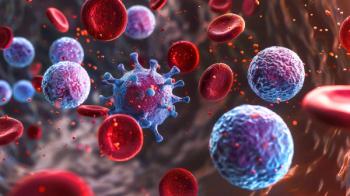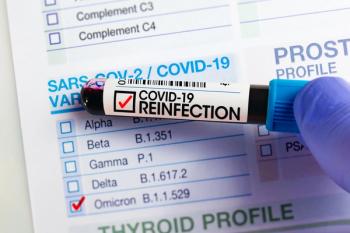
Hormone Therapy May Reduce Risk of Alzheimer Disease Pathology, Cognitive Decline in Women
Findings from 2 large datasets suggest hormone therapy may reduce Alzheimer risk, hippocampal atrophy, and cerebrovascular disease.
More than two-thirds of patients with Alzheimer disease are women, leading to increased interest in investigating the neurophysiological impact of estrogen decline during menopause, explained Jennifer Bruno, PhD, during a presentation at the 2024 Alzheimer’s Association International Conference (AAIC) in Philadelphia, Pennsylvania. Bruno, an instructor in the Division of Interdisciplinary Brain Sciences, Psychiatry and Brain Sciences at Stanford in California, explained further that while early evidence has suggested that hormone replacement therapy may provide neuroprotective effects against dementia, recent studies have demonstrated inconclusive effects, with some cases demonstrating harmful effects for patients with Alzheimer disease.
“There have been lots of studies focused on understanding why there is this disparity, and many factors have been proposed, but we know it is not simply based on the greater life expectancy of women. The brain, of course, is an important factor, and estrogen seems to be the key factor here,” Bruno said during the AAIC session. “We know that estrogen receptors are spread throughout the brain and expressed throughout the brain, and that estrogen is responsible for a host of neurobiological regulatory processes, including regulating neuroinflammation, the blood-brain barrier integrity, and synaptic plasticity. During menopause, estrogen declines, and it's that decline that may actually accelerate neuropathology development in women.”
Understanding the Menopausal Transition and Hormonal Changes
The menopausal transition is marked by significant changes in sex hormones, particularly a decline in ovarian estrogen estradiol (E2), explained Rebecca C. Thurston, PhD, FABMR, FAPS, Pittsburgh Foundation chair of women’s health and dementia; professor of psychiatry, psychology, and epidemiology; and director, Women’s Behavioral Health Program at the University of Pittsburgh. This period also sees rising levels of follicle-stimulating hormone (FSH) and increased importance of estrone (E1), the primary estrogen in postmenopausal women.
During the reproductive years, the hypothalamus communicates with the anterior pituitary gland via gonadotropin-releasing hormone, prompting the release of FSH and luteinizing hormone. FSH stimulates the ovaries to secrete follicles, which produce estradiol. This hormone, in turn, forms a negative feedback loop, suppressing further FSH release. However, as women transition through menopause, the ovarian follicles become depleted, leading to a decline in estradiol levels and a loss of this feedback mechanism. Consequently, FSH levels rise significantly, according to Thurston. This hormonal shift is a hallmark of menopause, with estradiol levels plummeting and remaining low in the post-menopausal phase, while FSH levels stabilize at a higher range.
In addition to estradiol, estrone becomes a more prominent estrogen during post-menopause. Although weaker than estradiol, estrone is produced from peripheral sources, primarily body fat, and plays a crucial role when estradiol levels are low. These hormonal changes have significant implications for brain health, according to Thurston.
Hormone Therapy as a Treatment Avenue
There has been a great interest in the potential use of menopausal hormone therapy as a therapeutic avenue for reducing Alzheimer risk and staving off cognitive decline among women, Bruno explained. However, the use of hormone therapy for this purpose is actually quite controversial.
“We now have accumulating evidence from randomized control trials demonstrating that generally we see increased risk of Alzheimer with hormone therapy with a pooled relative risk of 1.38. However, for observational studies, generally, we see a reduced risk of Alzheimer with a pooled relative risk of 0.78. Now 1 of the main differences between these 2 types of studies, of course, is the observational nature vs the controlled nature of a randomized trial,” Bruno said. “An observational study would tend to have a larger sample size, so they each have advantages and disadvantages and provide complementary information.”
But across both of these sets of studies, some important factors are emerging as being critical for this association, according to Bruno. These factors include genotype, age of hormone initiation (with earlier hormone initiation tending to be associated with a protective effect vs later hormone initiation tending to be associated with more of a risk factor), and the type of hormone therapy. Bruno explained further that estrogen-only hormone therapy seems to be predominantly associated with reduced risk, and estrogen-plus-progestin combination therapy tends to be associated with an increased risk or null findings.
To examine the association between hormone therapy and Alzheimer disease pathology, Bruno assessed data from the National Alzheimer’s Coordinating Center (NACC; N=3423) and the Alzheimer’s Disease Neuroimaging Initiative (ADNI; N=2422). Within the NACC dataset, Bruno noted the primary outcome was neuropathology assessed on the post-mortem brain, and within the ADNI data set, they leveraged the rich molecular imaging and fluid biomarker data, as well as looked at biomarkers of pathology.
Female participants were categorized based on their reported use of estrogen or combination hormone therapy (estrogen plus progesterone) prior to the outcome measurement. The study found that hormone therapy was associated with a significant reduction in the odds of Alzheimer pathology, as indicated by a lower National Institute on Aging–Alzheimer's Association Alzheimer’s Disease Neuropathologic Change score in the NACC dataset. This association was consistent for both combined hormone therapy users and those using estrogen-only therapy, with an odds ratio of 0.73.
Additionally, hormone therapy was linked to reduced odds of hippocampal atrophy and cerebrovascular disease. Bruno explained that these findings suggest that hormone therapy may offer protective effects against Alzheimer pathology, hippocampal atrophy, and cerebrovascular disease in women.
“When we turn to the biomarker outcomes, we also found a significant association between hormone therapy and primary amyloid outcomes. So, the use of hormone therapy was associated with reduced amyloid burden as measured by [positron emission tomography],” Bruno said. “We found evidence for a protective effect of [hormone replacement therapy] on dementia diagnosis, [Clinical Dementia Rating], and memory performance. All results were significant after controlling for age, APOE genotype, and educational level.”
With these results, Bruno noted that there is evidence for small but significant protective effects of hormone replacement therapy across multiple pathological and clinical measures in 2 separate cohorts. First, the protective effect of hormone replacement therapy on neuropathology indicates that HRT use is associated with a lower risk of pathology, relative to no HRT use. Second, the protective effect of HRT extended to amyloid biomarkers measured in vivo, indicating that future work can utilize these biomarkers to better understand the protective mechanism of HRT.
“Finally, the protective effect extended beyond pathology to more subtle cognitive outcomes,” Bruno said. “Together, these results lend understanding to the effects of [hormone replacement therapy] on the aging brain.”
REFERENCE
Bruno J, Thurston RC. Women’s Health. 2024 Alzheimer’s Association International Conference; Philadelphia, Pennsylvania; July 28-August 1, 2024.
Newsletter
Stay informed on drug updates, treatment guidelines, and pharmacy practice trends—subscribe to Pharmacy Times for weekly clinical insights.


















































































































































































































